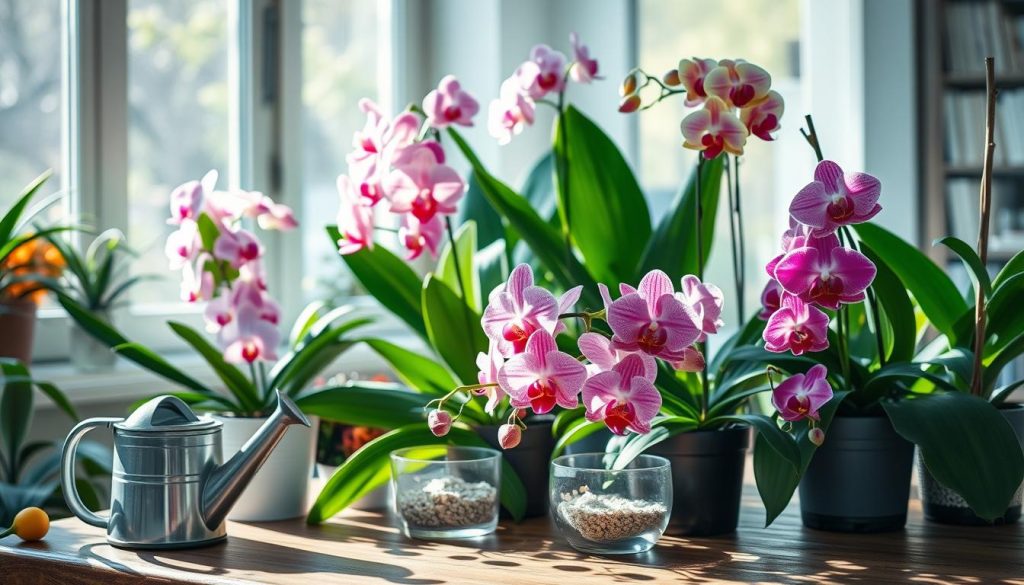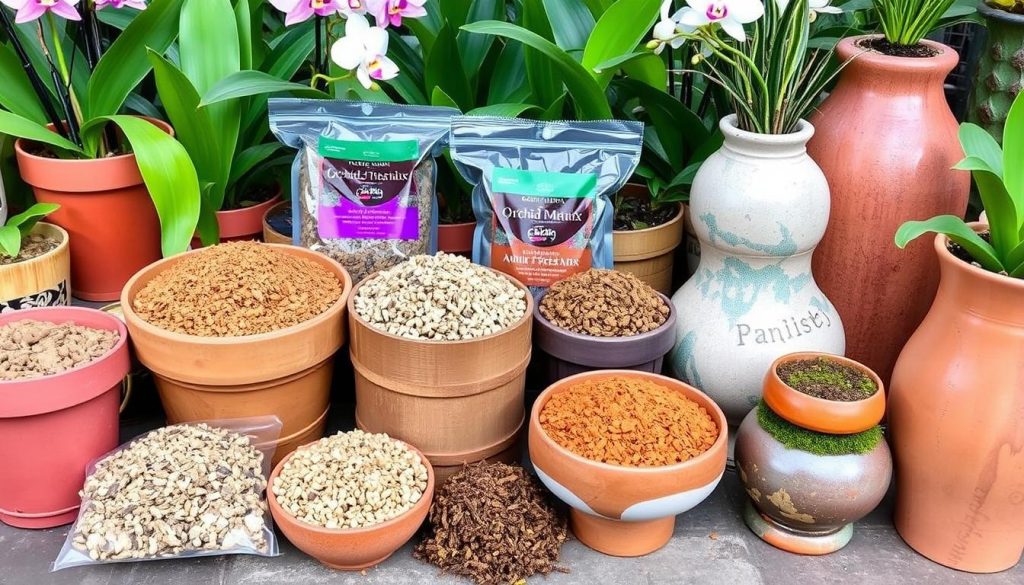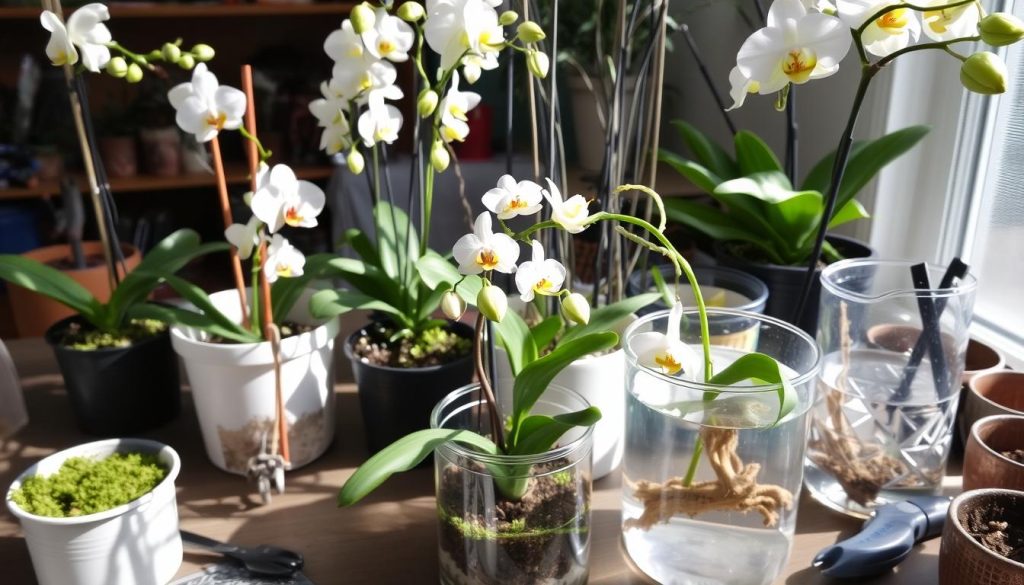Orchids are the largest family of flowering plants, with over 880 genera and a staggering 22,000 species. These plants grow on trees or rocks in tropical places. They make great houseplants, offering beautiful blooms that last for months.
Starting with orchid care at home means understanding their natural habitat. Orchids live in tropical climates, clinging to trees or rocky areas. They get moisture and nutrients from the air. By mimicking these conditions at home, we can help our orchids thrive.
In this guide, we’ll cover the basics of growing orchids indoors. We’ll talk about choosing the right types, watering, fertilizing, and repotting. Whether you’re new to orchids or already know them well, you’ll find helpful tips here.

Key Takeaways
- Orchids are the largest and most diverse family of flowering plants, with over 880 genera and 22,000 species.
- Orchids are epiphytic plants, meaning they grow on trees or rocks in tropical environments, making them well-suited for indoor cultivation.
- Proper care, including weekly watering, bright indirect light, weekly fertilization, and repotting when not blooming, is crucial for healthy orchid growth and blooms.
- Understanding the natural growing conditions of orchids is key to successfully growing them as houseplants.
- With the right care and attention, orchids can reward their caretakers with stunning, long-lasting blooms for months at a time.
Understanding the Basics of Orchid Plants
Orchids have fascinated gardeners for centuries. They come in many species, from delicate moth orchids to vibrant Cattleyas. Knowing how they grow helps us care for them better.
Types of Orchids for Home Growing
Some popular orchids for indoor growing are Phalaenopsis (moth orchids), Cattleya, Dendrobium, and Oncidium. These are known for their beauty and are easier to care for than some others.
Natural Habitat and Growth Patterns
Orchids grow on trees and other plants in warm places. They use their orchid roots and pseudobulbs to get moisture and nutrients from the air. Knowing this helps us create the right conditions for them to thrive indoors.
Basic Orchid Anatomy
Orchids have special aerial roots, pseudobulbs, and detailed flowers. Understanding these parts helps us care for our orchids and solve any problems.
Learning about orchids lets us appreciate these beautiful flowers more. It also helps us grow vibrant blooms in our homes.
Essential Growing Requirements for Healthy Orchids
To grow orchids, you need to know their specific needs. Orchid care tips and the right growing conditions are crucial. They help you grow these beautiful plants at home.
Lighting is key for orchids. They need bright, indirect sunlight. A south- or east-facing window is best. Too little light can stop them from blooming again.
- Orchids thrive in temperatures between 50 and 90 degrees Fahrenheit.
- They need humidity levels of 40 to 70 percent for healthy growth.
- Good air circulation is also critical, as stagnant air can lead to disease and pests.
Orchids don’t grow in soil like most plants. They need a well-draining potting medium. Proper watering and a balanced fertilizer are also important.
By understanding and providing the right conditions, you can create a natural habitat. This leads to healthy, vibrant plants and beautiful blooms.
Selecting the Perfect Location for Your Orchid
Orchids are beautiful plants that can do well in many homes. But, finding the right spot is crucial for their success. Each orchid type has its own light, temperature, and humidity needs.
Light Requirements and Exposure
Most orchids love bright, indirect light. East or south-facing windows are perfect. They give enough light without burning the leaves.
Look for light levels between 1500fc to 4500fc. This range suits many orchid types.
Temperature Considerations
Orchids need different temperatures. Some, like moth and oncidium orchids, prefer cooler temperatures of 50-75°F (10-24°C). Others, like many species, do best in warmer temperatures of 60-80°F (15-27°C).
Miniature cattleyas, for example, can handle normal household temperatures. They can even bloom more than once a year.
Humidity Levels and Air Circulation
Orchids need high humidity, between 60-80%. Bathrooms, kitchens, or rooms with a humidifier are great. You can also group plants or use a humidity tray to boost moisture.
Make sure there’s good air circulation. This prevents disease and keeps the air fresh.
Choosing the right spot with the right light, temperature, and humidity is key. This way, your orchid will thrive and give you beautiful blooms.
Proper Watering Techniques and Schedule
Watering your orchids right is key to their health and life span. They need a special balance of water to grow well. Water them deeply once a week, letting the soil dry out in between.
Use warm water and skip the leaves to avoid diseases. Change how often you water based on the orchid type, pot size, and where it lives. Water more when they’re growing fast and less when they’re not.
- Never let orchids sit in standing water, as this can cause root rot and other problems.
- Some growers use the “ice cube method,” placing two ice cubes at the base of the plant weekly to provide a slow, steady supply of moisture.
- Factors like humidity, air movement, potting medium type, and light levels can all affect the orchid’s water needs.
Watch for signs your orchid needs water, like the pot’s weight and the soil’s moisture. Healthy roots and leaves show they’re getting enough water when growing.
Wrong watering is a top reason orchids die. So, it’s vital to have a regular watering plan. Knowing how to water orchids and their water needs helps them bloom beautifully.
Orchids: Different Varieties and Their Care Requirements
The world of orchids is fascinating, with over 27,000 species found in nature. From the well-known Phalaenopsis to the rare Paphiopedilum, each type has its own needs and blooms differently. Knowing what each orchid needs is essential for keeping them healthy and blooming well at home.
Popular Indoor Orchid Species
Moth orchids, or Phalaenopsis, are the top choice for indoor plants. They can bloom for six to ten weeks, making them a hit with orchid lovers. Other favorites include Cattleya, Dendrobium, Oncidium, and Paphiopedilum, each with its own special traits and care needs.
Bloom Cycles and Characteristics
Orchid bloom cycles vary by species. Phalaenopsis can bloom all year with the right light and water. Paphiopedilum orchids, however, are rare and hard to grow. Oncidiums need steady temperatures and humidity, while Cattleyas have big, fragrant flowers. Knowing each orchid’s bloom cycle and characteristics is key to caring for them well.
With so many orchid varieties, you can easily add elegance and beauty to your home. By picking the right orchid for your space and learning its care needs, you can enjoy beautiful blooms for a long time.
Potting Media and Container Selection
Choosing the right potting media and containers is key for your orchids’ health. Orchids need a special potting mix for good drainage and air around their roots. Don’t use regular potting soil, as it can harm the delicate roots.
The best potting mix for orchids includes bark, charcoal, and pumice. These materials help create a well-aerated and fast-draining environment. Orchid potting mix formulas vary, but they all aim to balance moisture and air flow.
- Organic materials like tree bark, sphagnum moss, and osmunda provide nutrients and water-holding capacity.
- Inorganic materials like perlite, vermiculite, and charcoal improve drainage and aeration.
- Some growers also incorporate materials like lava rock or Aliflor for additional porosity.
For orchid pots, look for containers with lots of drainage holes and side openings. Plastic or clay pots are good choices because they drain well. Clear plastic pots let you check moisture levels easily.
Epiphytic orchids, like Phalaenopsis and Dendrobium, can grow in baskets or on boards. This setup provides the air flow they need. Make sure the pot isn’t too big for the plant to avoid water retention and root rot.

Repot your orchid every 1-2 years or when the mix breaks down. This keeps your orchid in the best conditions to bloom beautifully for years.
Fertilizing Your Orchid for Optimal Growth
Proper fertilization is key for your orchid’s lush growth and vibrant blooms. It’s important to know the types of fertilizers and when to use them. By following these tips, you can give your orchid the nutrients it needs to grow well.
Types of Fertilizers
For orchids, use balanced, water-soluble fertilizers made just for them. Look for the N-P-K ratio on the label, like “20-20-20” or “30-10-10.” Don’t use fertilizers with urea because orchids get nitrogen better from other sources.
Application Schedule and Methods
- Feed your orchid weekly at a quarter-strength or monthly at full strength when it’s growing.
- Don’t fertilize during the plant’s dormant periods to avoid overstimulation.
- Some people use the “weakly, weekly” method, giving a diluted solution every week.
- Flush the potting medium with plain water monthly to prevent salt buildup from fertilizer.
- Adjust the fertilizer based on your orchid’s growth stage and specific needs. Different orchids may need different nutrients.
By following these guidelines and adjusting your orchid’s fertilization routine, you can ensure it gets the right nutrients. Regular feeding and proper application are crucial for a healthy, thriving orchid.
Common Orchid Growing Challenges
Growing orchids at home can be rewarding but comes with challenges. Overwatering can cause root rot, while too little light can stop blooms. Growers must watch out for pests like aphids and diseases like fungal infections.
Yellow leaves often mean too much water, while wrinkled leaves mean not enough. Sudden changes in temperature or humidity can cause buds to drop early.
- Phalaenopsis orchids are usually the most susceptible to bud blast.
- Botrytis, causing spots on flowers, is typically seen on white or light-colored orchid flowers under persistently wet and humid conditions.
- Crown rot is most commonly seen in Phalaenopsis or Paphiopedilum orchids.
- Over-fertilization is a common cause of leaf tip die-back in orchids.
To fix orchid problems, quickly find the issue and change care routines. Right watering, enough light, and the right fertilizer are key to their health.
Orchids need special care to thrive. Knowing how to handle pests, diseases, and cultural issues helps growers enjoy these beautiful flowers for years.
Propagation and Repotting Guidelines
Keeping your orchids healthy means paying attention to their needs for propagation and repotting. Whether you’re new to orchids or have been growing them for years, knowing when and how to do these tasks is key. It helps ensure your orchids bloom beautifully for a long time.
When to Repot Your Orchid
It’s best to repot your orchid every 1-2 years or when the soil breaks down. The best time is after it finishes blooming and new growth starts. This lets the orchid adjust to its new home and grow strong roots.
Division and Propagation Methods
Orchids can be grown in different ways. Sympodial orchids, like cattleyas and oncidiums, can be divided when repotting. Each division should have at least 3 pseudobulbs for growth. Monopodial orchids, such as phalaenopsis and vandas, grow keikis, or baby plants, along their stems.
When repotting or dividing orchids, use clean tools and fresh potting mix. Cut off dead or damaged roots and handle the plants gently. This prevents stress. Let divided plants form a callus before repotting to avoid infections.

Maintaining Healthy Roots and Leaves
Healthy orchid roots are key for the plant’s health and growth. These aerial roots absorb moisture and nutrients. They should be firm and light green or white when dry. When repotting, trim dead or rotting roots to stop further damage.
Cleaning the orchid’s leaves with a damp cloth helps remove dust. This boosts light absorption and promotes healthy leaves. But, be careful not to get water in the leaf joints to avoid rot. Quickly deal with any disease or pests to keep your orchid healthy.
Good air circulation is also vital to avoid fungal problems. By following these tips for orchid root care and orchid leaf care, your orchid will stay vibrant and ready for blooms.
- Trim dead or rotting roots during repotting to maintain healthy growth.
- Clean leaves gently with a damp cloth to remove dust and increase light absorption.
- Avoid getting water in leaf joints to prevent rot.
- Address any signs of disease or pest infestation promptly.
- Ensure adequate air circulation to prevent fungal issues.
Encouraging Reblooming in Orchids
Orchid lovers can’t wait for their plants to bloom again. Some orchids bloom once a year, but others can bloom many times. To get your orchid to bloom again, you need to know what it needs and give it the right home.
Post-Bloom Care
After your orchid finishes blooming, it needs special care. For most, you should cut the flower spike close to the base. But, some like Phalaenopsis might bloom again from the old spike, so don’t cut it. Keep giving your orchid the right amount of light, water, and food during this time.
Triggering New Flower Spikes
To get new spikes, some orchids need a cooler temperature for a few weeks. This change tells the plant it’s time to bloom again. Make sure your orchid gets enough light and keep up with regular feeding. Remember, it might take months for your orchid to bloom again, depending on the type.
Some orchids, like Phalaenopsis, need cool nights to start new spikes. Knowing what your orchid needs helps you create the best environment. This way, you can enjoy its blooms over and over again.
Pest Prevention and Disease Management
Keeping your orchids healthy is essential, and it begins with preventing pests and diseases. Regularly check your plants for any signs of pests or diseases. This includes looking at both leaves and stems. Also, isolate new orchids before adding them to your collection to stop pests from spreading.
Common pests like spider mites, scale insects, and mealybugs can harm your orchids. They can cause yellow leaves, slow growth, and early leaf drop. Use insecticidal soaps or neem oil to treat these pests. For severe cases, you might need to use pesticides like Malathion or Orthene.
Fungal and bacterial diseases often come from bad air circulation or too much water. Look out for blackened roots, discolored leaves, and slow growth. Improve air flow, change how you water, and use fungicides for serious cases. Keeping your orchids clean by removing sick parts helps stop disease from spreading.